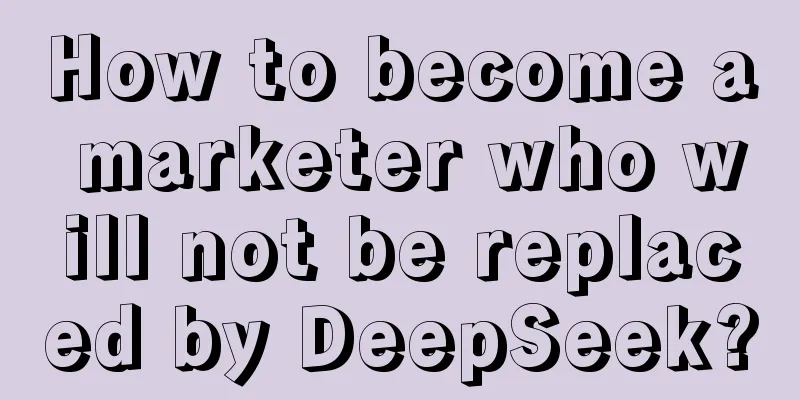How to become a marketer who will not be replaced by DeepSeek?

Can AI creation completely replace human creation? I believe many brand people have considered this question. In 2024, Coca-Cola conducted an "experiment". On Christmas Eve last year, Coca-Cola released a TVC "The Holiday Magic is coming" produced entirely by AI, recreating its 1995 classic Christmas commercial "Holidays Are Coming". Once the short film was released, it caused heated discussions across the Internet. Previous: 1995 “Holidays are coming” Next: 2024 “The Holiday Magic is coming” "CocaCola is 'red' because it is the blood of unemployed artists!" "Sucks the heart and joy out of classic advertising" “Completely soulless, in stark contrast to the Real Magic at the end” In this debate, we can see content creators who have a vested interest in the company, as well as pure consumers. Disney screenwriter Alex Hirsch pointed out on the social software X that "CocaCola is red because it's made from the blood of out-of-work artisits!" Among consumers on the other end, the majority hold opposing views. Many netizens believe that compared with the 1995 TVC starring real people, the video created by AI lacks real emotions and does not convey the joy of Christmas at all. Some even commented, "I bought a Pepsi today because of this advertisement." In fact, since the advent of ChatGPT, discussions about the boundaries and ethical standards of AI technology have never stopped. However, in the Chinese world, the emergence of DeepSeek has truly brought this discussion to a climax. At the beginning of the year, there was a screenshot of a conversation that caused a stir in the industry. The content was that Shangmei Group required the reduction of the team, involving multiple departments such as legal affairs, customer service, and product innovation, among which the content department had the heaviest elimination rate. Not only did it say that "80% of the people in the content innovation department should be eliminated", but it also included "the ability to use AI" in the hard indicators of the 20% retention. As DeepSeek R1 has the ability to create highly anthropomorphic, emotional, and logical content, it quickly attracted nationwide attention. Some people call it China's "iPhone moment," marking another leap forward in AI technology; others worry that this lifelike technology will blur the boundaries between humans and machines, and even threaten the uniqueness of humans. This concern is even greater for brand marketers whose main output is deep insights and creative strategies: When AI-generated copywriting, video scripts, and even strategic plans begin to approach professional standards, will the creativity and insights that marketers are proud of be replaced by algorithms? Is AI a tool to liberate productivity, or a "job killer" that replaces humans? We interviewed more than a dozen practitioners in the brand marketing industry, including founders of new retail brands and top service providers, as well as front-line brand planners, media executives, and content operators... We tried to explore from their perspective how marketers can find their own foothold in this great change, and where our value as "people" lies. 1. Fear: Cutting basic positions while recruiting "AI+" compound talentsThis concern is not groundless. In 2023, BuzzFeed, known as the "Today's Headlines" in the United States, announced that it would reduce about 12% of its employees, mainly content creators, and switch to using AI technology to generate content. According to McKinsey's forecast, by 2030, 375 million jobs worldwide will be affected by AI and automation technology, including layoffs, job transfers, and changes in skill requirements. If numbers still feel distant, this trend is felt more strongly in conversation. “Since last year, we have laid off half of our design department, which originally had about 70 people, but the output has not changed,” a senior executive of a service provider told us. The traditional marketing industry has long relied on a large amount of manpower input, whether it is market analysis, content creativity, advertising production or delivery conversion, it all requires the collaboration of professional teams. But now, all of this is being rapidly reconstructed. Since the major technological breakthroughs of large models such as ChatGPT are in content generation, content has become the fastest part to be disrupted. In our conversation, more than half of the respondents said that the basic copywriting and design of the company are almost all completed by AI. Judging from the practical results, in actual work, compared with human creation, AI has two main advantages: one is the high efficiency of mass production; the other is the low cost of training to produce qualified content. This has also become the reason why AI can compete for jobs. In the past, relying on manpower, we could produce 100 pieces of content a day to attract traffic; but with AI, we can use the same manpower cost to batch create 1,000 or even 10,000 pieces of content in exchange for more traffic, achieving a several-fold increase in operational efficiency. An AI marketing technology provider gave us an example of one of their typical service scenarios. Now many new car companies require KOS, and store salesmen are required to post articles on social media such as Xiaohongshu and Douyin to attract traffic, but most traditional salesmen lack copywriting skills, and training will increase the workload. In this case, these car companies will find them to use AI to produce content in batches and then distribute it to stores. He revealed that in the past, store sales content generally scored 40-50 points, but AI can achieve 70-80 points. When the requirements for content quality are not too high, AI becomes a more cost-effective option. In the early days of ChatGPT, AI was mostly used in informal content such as UGC and PUGC, because people were still skeptical and cautious about AI-generated content. However, with the rapid iteration of technology, AI-generated content has become more mature, and AI can be seen in more and more scenarios. According to a survey by Advertiser Perceptions, about 60% of advertisers were open to this in 2023, but this year, nearly 70% of advertisers are willing to place ads on AI-generated content. If at the end of 2022, after the emergence of ChatGPT, more companies applied AI for the purpose of gimmicks and curiosity, now everyone truly believes that large models can improve production efficiency. And any tool that can improve production efficiency will be quickly embraced by the business world, and AI is no exception. "AI has become the infrastructure of our company," the CEO of a snack brand told us. "In today's recruitment needs, AI is a basic skill, just like Word, Excel, and PPT in the past." They are in the expansion stage and have not reduced their positions due to AI, but will include the mastery of AI in the existing personnel consideration standards. Knowing how to train AI models and how to optimize prompt words to make the generated content more in line with needs is becoming an "essential skill" for employees. In BOSS Direct Recruitment, we can already see that some e-commerce platforms and brands are recruiting for "AI content creation" positions with high salaries. From the job description, we can see that applicants need to be "AI + creation" compound talents, who must be proficient in using AI content generation tools, and also have solid content expertise and data sensitivity. At the same time, some basic positions have also had to face elimination. In actual research, we found that simple copywriting, data analysis, and content editing positions are rapidly shrinking in most companies. We have to admit that AI technology is changing every aspect of the industry, from improving production efficiency to restructuring the employment structure. For enterprises, how to integrate AI into the production process is the key to maintaining competitiveness in the future; and for everyone in the industry, understanding and applying AI has become an unavoidable topic. 2. Acceptance: If you can’t beat them, join them and turn AI into a “tool”Embracing, rather than avoiding, is the choice of most people in this AI wave. In a conversation in early February, the interviewee gave us a text version of his answer before the face-to-face chat. This answer was logically clear, comprehensive, and well-organized, and was produced by their internally trained AI model. "AI has become an expert in our company. For some business questions, its answers may be more comprehensive than mine, so I'll give you one first," he said. AI has been promoted to a strategic level in the company. Since DeepSeek appeared at the beginning of the year, their founder has been obsessed with AI research and took the lead in building an internal AI knowledge base, feeding all existing cases and opinion documents into the model. Now, simple text manuscripts and video scripts in the company are all produced by AI first. The deep integration of AI and business is not an isolated case. After the Spring Festival, the Daofa community conducted a survey on the use of DeepSeek. Among hundreds of responses, 80% of the respondents had used DeepSeek, and 20% of them had already used it proficiently in their work. For marketers who are already accustomed to AI, AI is like a "tool man". As long as you master the use method, it can become a perpetual motion machine to maintain efficient output. In last week's knife skills sharing, Feiyang, the founder of Feiyang Content Strategy, classified the use skills of DeepSeek into four principles - mentor principle, progressive principle, cross-dimensional principle, and feeding principle.
Taking the analysis of the Douyin opportunity of children's learning chair as an example, Feiyang demonstrated to us in detail the application of these four principles in track analysis. Do some preparation before asking formal questions: upload theoretical materials so that DeepSeek has basic knowledge. The first round of questions and answers used the "feeding principle" to directly provide DeepSeek with the expected analysis framework for it to think about: "Based on Feiyang's SGOT category track model (category scale, category growth rate, category competition, category opportunities) four dimensions, analyze the growth opportunities of children's learning chairs on Douyin." From DeepSeek’s answer, we can see that it will strictly follow the SGOT framework to output the analysis, and finally give suggestions on the two major categories of opportunities: “Function Visualization” and “Sitting Posture Correction”. After having a general direction, we followed the "progressive principle" and conducted in-depth research on the "sitting posture correction" category in the second question: "If we focus on the concept of children's sitting chairs, is there any opportunity?" This time, DeepSeek conducted an analysis and summary from five aspects: market demand, competitive landscape, product innovation, marketing, and risk, and made further detailed suggestions on the opportunities in the sitting posture correction track: in terms of product dimension, it can be intelligent or have new technological innovations; in terms of scenario dimension, it can target the two strong demand groups of "health + education"; in terms of channel dimension, it is recommended to go to the sinking market and make "quality and price ratio". At this point, the track opportunities provided by DeepSeek are relatively clear, and there are also strong demand scenarios, which can be extended to the direction of landing. Therefore, after the third round, we can try to use the "cross-dimensional principle" to let DeepSeek do cross-category comparisons. For example, ask questions such as, "What are the opportunities for a lumbar support cushion designed specifically for children, similar to BKT (cross-category)?", "Children's posture chairs (learning chairs), posture cushions (children's version of BKT), and children's correction belts, please compare which product has better growth opportunities?" to allow DeepSeek to conduct in-depth exploration. It can be seen that throughout the entire interaction process, whether in terms of the breadth of data collection or the depth of logical analysis and opportunity capture, AI can match the industry average. However, no one is perfect, and AI also has its own problems. Most AI models tend to "make up stories", so if the generated content is to be used in serious situations, it is necessary to double-check the information source and cross-check on multiple platforms. In addition, each model has different areas of expertise. For example, DeepSeek is good at "human sense" and divergent thinking; ChatGPT is more reliable in logical thinking. After understanding their respective characteristics, we can maximize efficiency by using specialists for their specific purposes. However, even though we have become accustomed to working with AI, we still have to worry about AI that has better knowledge and logical analysis than ordinary people: Do we in the brand marketing industry still have value that cannot be replaced by AI? And how can we prepare for the rainy day? 3. Frankly: AI cannot achieve 90 points because logic cannot "empathize"“AI can write copywriting to a score of 70 or 80, but 90 still depends on humans,” an AI marketing practitioner told us. In his service experience, some companies want AI to directly generate content with a score of 90, but they will directly tell the other party that it is difficult for AI to do so at this stage. Data and logic are the advantages of large models and the basis for their rapid batch generation, but they are also destined to lack human emotions. The model capability is determined by the algorithm. The capability of the same model is fixed. It is the user who really causes the difference in the generated content. This practitioner told Daofa that the services they provide to brands are not to make algorithmic changes to the big model, but to help brands understand consumers more deeply through experience and insights, find the relationship between brand selling points and consumer buying points, and convert them into prompts that AI can understand. Understanding is the basis of expression. If you can’t understand emotions, you naturally can’t express and convey them. Just like Coca-Cola mentioned at the beginning, although the shooting technology in 1995 cannot be compared with the exquisiteness of the pictures in the TVC in 2024, the joy revealed in the eyes of real people is something that AI cannot interpret and replace. Beyond the personal perspective, how to meet consumer needs in the AI era has become a bigger proposition that brands need to solve: If AI becomes a part of consumers' work and life, what changes will occur in consumers' shopping decision chain in the future? How can brands establish closer connections with consumers? A practitioner in the relevant industry told us that some brands have commissioned them to conduct research on the impact of AI on consumer cognition and behavior. In addition, he also found that in the past two years, there has been an obvious phenomenon: more brands want to hold offline activities. After the online traffic dividend reached its peak, more and more brands discovered that offline is the place where brand value can be truly realized. Just like Tagi., which we disassembled before, its sales surged after the opening of its first store on Wulumuqi Middle Road in Shanghai; its high-volume social media breakthrough was triggered by flash mobs with great visual impact and brand memory. The impact brought by the high saturation of red, yellow and blue, and the childlike innocence brought by the unrestrained architectural form, are still irreplaceable in the virtual world. And it is precisely such instant and intense sensory experience that can produce dopamine and lead to purchasing decisions. Lululemon, known as a "religious brand", also started offline, from a group of "super girls" who pursued a healthy lifestyle. What really connected these girls was the regular yoga and Pilates, and the sense of identity and value resonance generated by participating in community activities and sharing. From the most fundamental point of view, the biggest difference between AI and humans is that it is driven by algorithms. The output of each token is a result of probability. Although AI can generate a large amount of content, the basis of its creation is existing data and models; although AI has a neural network-like thinking structure, it still cannot understand the emotions behind the text. We cannot predict whether AI will be truly conscious in the future, but today, the most basic understanding and empathy that we have as human beings, the heartbeat and excitement brought by holding hands, hugging, and face-to-face communication, are still irreplaceable. IV. ConclusionWe asked DeepSeek a question: If you were a human, what are the ten things you most want to experience in your lifetime? The answer it gave was:
Without exception, they are all interactions with nature and people, and they are all personal experiences that require sensory participation. Perhaps this is also the most unique thing about humans in AI cognition. Finally, after reading our article, DeepSeek said: (The following content is generated by DeepSeek and does not represent the author's value orientation)
Either let AI do the heavy lifting for you, or wait to be moved by AI - which side are you on in this war? Author | Li Zi |
<<: What is a scenario? Define the "field" power of the product!
>>: Data analysis empowers sales, these strategies are amazing
Recommend
Behind Decathlon's 10 billion annual sales: a differentiated strategy centered on experience
There is a brand that adopts an "experience-c...
How much does Amazon Japan charge in monthly rent? How does Amazon operate?
With the rapid development of e-commerce, Amazon, ...
Is it legal for cross-border e-commerce to import and sell domestically? Which one has higher profits, domestic sales or foreign sales?
With the development of globalization, cross-borde...
List of cross-border payment institutions
If domestic buyers want to buy things on cross-bor...
How did I save 30 million in advertising fees by creating a "hot topic" in 3 steps?
Brands have made chasing hot topics the mainstream...
How to change prices on Shopify? What are the tips?
When doing cross-border e-commerce, the relevant p...
Write the year-end summary in the workplace like this, don't be lazy, don't lie down, and don't suffer losses
At this time of year, most people in the workplace...
Is Shopee a cross-border e-commerce platform? A detailed registration process
In recent years, with the rise of cross-border e-c...
How does Shopee's overseas warehouse in Mexico operate? How does Shopee's overseas warehouse ship goods?
Shopee platform has set up overseas warehouses in ...
With the European Cup approaching, can Chinese overseas brands still reap the benefits?
Chinese brands are gradually going abroad and work...
What is the process for opening a store on a cross-border e-commerce platform? How to do it?
More and more merchants want to open stores on cro...
How can I contact Shopee's account manager? How can I contact Shopee's customer service?
Merchants who want to join Shopee must first compl...
Party A’s secret weapon: Other brands can also be used
The solution is great, but "other brands can ...
This year's Double 11, luxury goods are only for young people to buy
It's another Double Eleven, and merchants and ...
What activities will Shopee Chile have in October? Detailed information
Registration for the October Shopee Chile event is...









